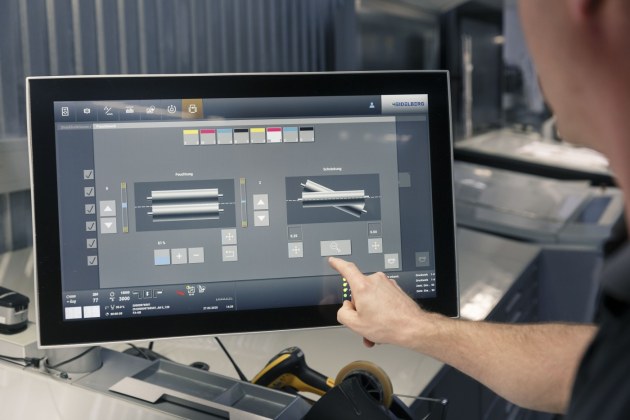The world's biggest offset press manufacturer, Heidelberg, is launching its new Speedmaster range, which it describes as the most intelligent and automated ever produced.
The packaging market represents a key sector for Heidelberg. Its new generation Speedmasters are designed for non-stop printing in variable run lengths, short, medium and long. The company says the new Speedmasters can produce up to 90 million sheets a year.
Heidelberg sells more presses than anyone, even in these strained times; and it has a new focus on its core products – sheetfed offset B1 and B2 sized presses. The new generation of Speedmasters combines the latest mechanical and electrical engineering developments with cloud-based internet technology.
The new Speedmaster series has a completely redesigned Prinect Press Center generation, with the new Speedmaster Operating System, delivering Push to Stop functionality and connection to the Prinect Cloud to every press.
The presses have a host of new features including digitgally controlled dampening, wash-up reduction, zero defect print, and specific functionality for packaging, commercial, and security printing.
The core concept for Heidelberg is Push to Stop. Introduced at drupa last time out, the concept essentially means that the new generation of presses are designed for continuous printing.
New digital assistance systems, such as the Wash Assistant or Intellirun on the Wallscreen XL, allow the operator to continuously call on the machine’s performance potential.
The hardware has evolved as well. In addition to the new and significantly larger 24-inch multi-touchscreen, the standard illuminant lighting to ISO 3664:2009 was converted to LED. Instead of time-consuming tube changes, as before, switching between standard illuminant D50 and D65 with and without UV is now done simply by pressing a button.

“Following the overwhelming success of Push to Stop at the drupa 2016, we have invested a great deal in advancing the idea of the Smart Print Shop and in taking Push to Stop to a new level” Rainer Wolf, head of sheetfed product management, said.
Software development plays a key role in this. Heidelberg, however, has also heavily invested in press technology, closing automation gaps, further optimising subprocesses, and developing new applications.
Heidelberg has automated the dampening unit of the Speedmaster XL 106 with the new Hycolor Pro. The quantity of dampening solution is decided and metered between pan roller and metering roller. The pressing/squeezing required for this purpose can now be carried out by automation directly from the Prinect Press Center.
Wolf said, “With Hycolor Pro, we now have defined and measurable settings we can also use for digital Remote Service. From the control panel, the printer can now meter more or less dampening for one side, thus react faster and more sensitively, and approach the scumming point much more precisely. This creates stable production run conditions with less waste paper and faster reaching of the good sheet.”
Apart from the new Wash Assistant software for intelligent determination of the degree of soiling and preselection of the optimum washup program, further innovations relate to the area of washing fluid supply. Besides water, up to three more media, such as washing fluid for conventional and UV inks, roller protection fluid or deep cleaners, can now be metered in the inking unit.
The modules of the blanket washup device in the Speedmaster XL 106 were made 20 per cent lighter, and a fully automated impression cylinder washup device is now available for the coating unit. In particular with perfecting presses with coating unit, approximately 50 hours of manual cleaning time per year can thus be saved in three-shift operation.
Heidelberg says it is providing its customers with new applications that enable them to expand their portfolio and address new customer segments. These include FoilStar Cure, the adhesion of cold foil on in-mould label foils can be increased to a level that permits stable productions runs. Further modifications to the FoilStar offer the possibility of embossing hologram effects into the coating layer using the cast and cure method, and of curing the layer with LED.
In the area of rotary die-cutting, the successful Speedmaster XL 106-DD will be complemented by the Speedmaster XL 106-D with just one die-cutting unit. This provides a less costly alternative sufficient for many applications.
The fully automated non-stop system of the Speedmaster XL 106 has also been redesigned, and, in addition to increased robustness for folding carton printing, now offers the option of rack operation for thin materials, for example in label printing.
A number of technical features for security printing, such as ink fountain for rainbow printing, or devices for waterless offset and letterset, were transferred from the Speedmaster XL 75 to the XL 106.
A new coating supply allows minimal circulation quantities, which saves costs, especially with special applications involving expensive coatings.
The Speedmaster XL 106 is now available with special equipment for substrate thicknesses of up to 1.6 mm.
In the area of applying dispersion coating on both sides in a single pass, the speed of previously 15,000 sheets/hour can now be increased to 18,000 sheets/hour with the Speedmaster XL 106 and optimised drying with just two dryer units before perfecting.
The new Speedmaster XL 75 has been fully redesigned and updated to the latest ergonomic standards. The maximum speed of the straight printing version was raised to 16,500 sheets/hour, with an optional increase to 18,000 sheets/hour. Heidelberg says that in combination with the new Prinect Press Center XL 3 and the range of new assistance systems, the Speedmaster XL 75 sets the standards in the 50 x 70 cm format.






